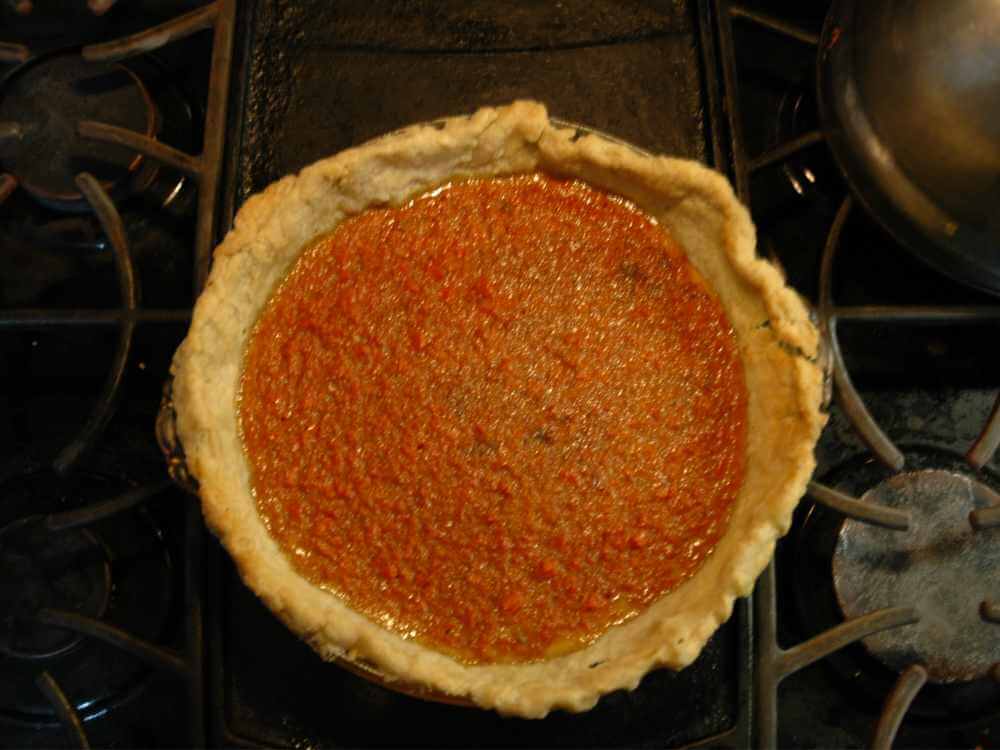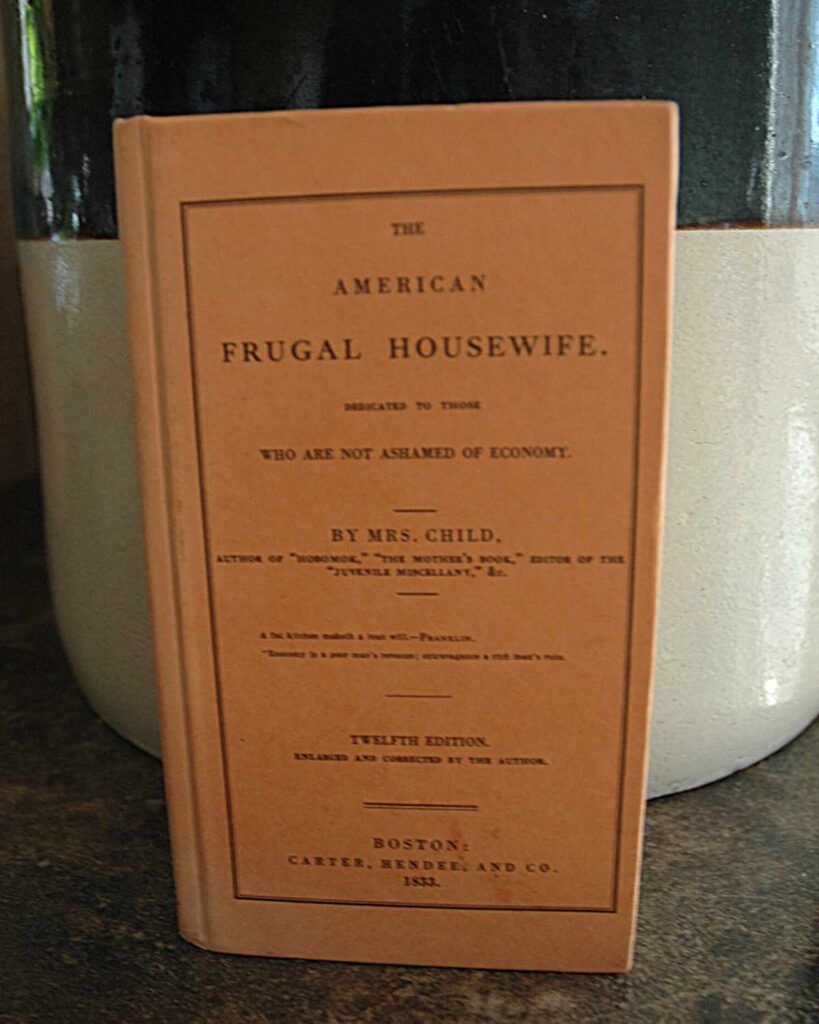This post was last updated on January 2nd, 2023 at 12:52 pm
When I first saw the book title, “The American Frugal Housewife. Dedicated to Those Who Are Not Ashamed of Economy,” it spoke to me. Not so much the “housewife” part but the dedication. I am not ashamed of being frugal. Far from it. That this book was written nearly 200 years ago didn’t bother me either. As outdated as “Frugal Housewife” might seem, much of its advice remains as relevant as ever. If you’re interested in becoming more frugal this year, it’s a worthwhile read.
First published in 1828, “Frugal Housewife” is considered one of the nation’s first self-help books. It’s no longer protected by copyright, as far as I can tell, and you can find free PDF copies online. I picked up a hard copy for about $3. The author, Lydia Maria Child, is best known for her poem, “Over the River and Through the Woods.” She was also an outspoken opponent of slavery and an advocate of women’s rights, positions that cost her book and magazine sales. She struggled financially for many years because of her husband’s failures but reportedly died in 1880 having saved the “equivalent of three quarters of a million of today’s dollars.”
‘Frugal Housewife’ in proper context
Reading “Frugal Housewife” was a humbling experience, as the book makes our modern-day efforts to reduce consumption appear amateur. To be fair to our generation, Lydia Maria Child lived during an era not yet dependent on mass production for manufactured goods or food. For many people in the early 1800s, self-reliance was simply a way of life. Today, self-reliance is almost a luxury. Our economy has become so specialized that many people lack the skills to do much more than a certain set of narrow, occupational-related tasks. Few among us today can build something useful with our own hands, grow our own food, cook a complete meal with that food, and also preserve whatever is left.
Her advice is idealistic by modern standards, especially her perspective on raising children. Kids today know relatively little in terms of life skills, and Child laments the youth’s lack of resourcefulness, even in 1828. “Begin early is the great maxim for everything in education. A child of six years old can be made useful; and should be taught to consider every day lost in which some little thing has not been done to assist others,” she writes. She then goes on to list all the things that children can do, including patching their own clothes and picking “cranberries from the meadow, to be carried to market.”
It can be hard to relate to some passages from “Frugal Housewife.” When I read aloud the part about children being “made useful,” our youngest child was less than amused. He told me the book would make a good fire starter. I couldn’t blame him for thinking that, honestly.
The wisdom throughout ‘Frugal Housewife’
Nevertheless, I discovered nuggets of wisdom sprinkled throughout the book. Apparently, keeping up with the Joneses was a problem nearly 200 years ago. The author warns: “Not one valuable friend will be gained by living beyond your means, and old age will be left to comparative, if not to utter poverty.”
Here are a few more of those nuggets of wisdom:
- “Self-denial, in proportion to the narrowness of your income, will eventually be the happiest and most respectable course for you and yours.”
- “The man who is economical, is laying up for himself the permanent power of being useful and generous.”
- “The true economy of housekeeping is simply the art of gathering up all the fragments, so that nothing be lost. I mean fragments of time, as well as materials.”
- “It is wise to keep an exact account of all that you expend–even a paper of pins.”
- “Begin humbly. As riches increase, it is easy and pleasant to increase in hospitality and splendor; but it is always painful and inconvenient to decrease.”
- “We shall never be free from embarrassment until we cease to be ashamed of industry and economy.”
A timeless element of frugality: Waste nothing
In addition to imparting her wisdom, “Frugal Housewife” contains a lot of tips on running a household, though modern technology makes some of them irrelevant. Regardless, all these tips serve as a reminder that, years ago, people relied on their own ingenuity and resources to tackle life’s problems. They made due with whatever was available and wasted nothing.
Perhaps no part of the book illuminates her waste-nothing attitude more than the sections on butchering and cooking meat. She talks about preparing all parts of the animal, including the organs and head.
“Pig’s head is a profitable thing to buy. It is despised because it is cheap; but when well cooked it is delicious. Well cleaned, the tip of the snout chopped, and put in brine a week, it is very good for boiling: the cheeks, in particular, are very sweet; they are better than any piece of pork to bake with beans. The head is likewise very good baked about an hour and a half. It tastes like roast pork, and yields abundance of sweet fat, for shortening.”
Read: Fight inflation with productive leisure
How to follow a recipe from 1828? Guesswork required
If you decide to cook something from this book, be advised that it was written before standardized cooking measurements. You’ll see references, such as “a gill of milk” and “a bit of shortening half as big as a hen’s egg.” Also, some of her recipes contain weird ingredients, such as pearlash. But a little “googling” will clear up any confusion. (Pearlash is a leavening that can be replaced with baking powder.)
You’ll also notice she doesn’t provide any oven temperatures because hers is wood burning. Rather, she describes temperature by referring to the intensity of the oven coals. She’s even frugal about the wood she burns, preferring pine to hardwoods. “A smart fire for an hour and a half is a general rule for common sized family ovens, provided brown bread and beans are to be baked.” My own guess of a “smart fire” is an oven at about 350 degrees.
You’ll also learn that, in the 1800s, puddings were very popular. Reading the section on puddings reminded me of the scene from the movie “Forrest Gump,” in which Bubba lists all the different ways that shrimp can be prepared. Child includes recipes for baked Indian pudding, boiled Indian pudding, flour pudding, bread pudding, rennet pudding, custard pudding, rice pudding, bird’s nest pudding (made with cored, whole apples), apple pudding, cherry pudding, cranberry pudding, whortleberry pudding, plum pudding, and hasty pudding. Whew!

Carrot pie: My first ‘Frugal Housewife’ recipe
I wanted to make one of her recipes, and her carrot pie jumped out at me. Why this particular dessert? Well, I’ve made carrot cake, and I’ve made pumpkin pie—but never carrot pie. And our family loves carrots. I followed her instructions the very best I could. But I had to guess on some of the ingredient proportions (and did peek at the internet for some guidance). The results were better than expected, as my daughter declared after she had a bite, “This is actually pretty good.”
I’ve included my recipe below in case my readers want to make it.
Andrew’s carrot pie (inspired by ‘Frugal Housewife’)
| Chopped carrots | 2 heaping cups |
| Milk | 3/4 cup |
| Eggs | 3 |
| Sugar | 1/2 cup |
| Cinnamon | 2 heaping teaspoons |
| Salt | 1 teaspoon |
| Lemon zest | 1 lemon |
Steam or boil the carrots until they’re very tender. Mash them. Add milk, eggs, sugar, salt, lemon zest, and cinnamon. Mix the ingredients well. Then pour the mixture into the prepared crust. Bake in a preheated, 350-degree oven for about 1 hour. Serve the pie with whipped cream or ice cream.
Next up, dandelions
What else might I try? Well, I know dandelions are edible and drinkable. My mom used to pick their tops for her parents to use in making wine. We have an abundant supply in our yard, and we don’t use herbicides. Child recommends boiling them for 30 to 45 minutes. “Dandelions are very much improved by cultivation. If cut off, without injuring the root, they will spring up again, fresh and tender, till late in the season,” she writes.
I usually feel like I’m at war with this “weed,” one that I’m always losing. But I like the idea of turning this “weed” into something edible. In the spring, I will let my readers know how boiled dandelions taste!
In the meantime, if you read her book, let me know if you make anything from it. I’d be curious how it turned out.
Other good frugal reads
One final note: If you want to become more frugal but would prefer more modern advice, I recommend grabbing a copy of “The Complete Tightwad Gazette” by Amy Dacyczyn. It’s a compilation of her newsletters published in the 1990s. I also include this book in my list of “4 books to inspire you to become more physically active.” Some of it, namely the parts about using the internet, is already outdated, but much of it remains very relevant.
Read: Whole foods are stars of the Frugalmatic diet
Also, I discover a lot of frugal tips by reading the magazine Consumer Reports. I’ve saved a lot of money over the years by following its advice, such as tips for persuading internet companies to lower your bill (Hint: You’ll want to ask for your service provider’s consumer retention department). Before buying an issue of this magazine, be sure to check with your local library’s online offerings to see whether you can access Consumer Reports for free!
Ultimately, leading a frugal lifestyle isn’t about getting good deals but about limiting your consumption and getting the most out of what you do consume. A waste-nothing attitude goes a long way toward minimizing expenses and maximizing savings.

